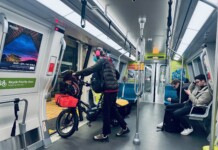By Keir Lee-Barber
Over the last several years Salt Lake City has seen a bustling growth in popularity of cycling. Biking supports a diverse culture, from road riding and mountain biking to family excursions in City Creek; Salt Lake City caters to us all and it is no surprise this growth is occurring. “One of the things that’s nice about what’s been happening in the last five years is the number of bikes on the street goes up, quiet exponentially it seems, every year…bikers out there are increasing,” said David Davis, the Executive Director of the Salt Lake City Bicycle Collective. This February he met with Becka Roolf for a discussion on both the increase in cyclists as well as the increase in the rate of traffic-bicycle collisions. When the question of the growth in the riding community was posed Becka Roolf, the Bicycle Coordinator of the SLC Transportation Division, offered several contributing factors, “I think the increase in bicycle facilities are attractive to people, it gives them the possibility to do their commute or errands or going to visit friends by bike. I also think gas prices are a contributing factor…the bicycle is a vehicle that allows you to move quickly through a fairly short distance commute… It is an economical form of transportation.”
Generally, the Western States have the highest bicycling rates across the US; while the Southern states traditionally have the lowest levels of participation in any form of bicycling. In 2011 Utah saw its largest jump in cyclists with an increase of 25% over the reported number of cyclists the previous year. Looking at the data collected by volunteers during the most recent annual Salt Lake City Bike Count the accelerated growth was slowed. The 5 day count occurs every year each September; the 2013 count brought notably lower reporting’s of bicyclists in the city, as the week of collection was impacted by inclement weather. It was proposed that the rain kept everyone indoors, however a recently published extensive study of cycling in New Zealand surprisingly found the wind speed of gusts was in fact often a larger factor in forcing cyclists into retreat.
The participation of women in the cycling was impacted little by the rain of 2013, with a showing of 20% female cyclists, a decrease of only 1% compared 2012. As a whole when cyclists are divided across gender lines, Salt Lake City is slightly lower than the national average of 24%. These numbers are outliers in comparison when looking at rates in countries in Northern Europe, where it has been shown no significant differences in cycling rates among sexes are found.
The SLC count of 2013 found higher rates of women in areas which are more recreation and cyclist friendly, such as those surrounding the University. The percentage of women cyclists at these collection points increased to over 25%, just passing the national average. This is in keeping with a recent study in London which found that bicycle “usage at weekends and within London’s parks characterizes women’s journeys, whereas for men, a commuting function is more clearly identified.”
Following from the idea published in the London study it can be noticed that observational bicycling studies within the United States often report low findings for female participation in cycling, with the larger share always being males. However a nationwide comprehensive survey of the US found brighter results. The National Household Travel Survey, undergone in 2009, found that of the respondents who reported riding a bicycle within the past week, 40.3% were women. Similarly an earlier question based survey by the Outdoor Industry Foundation, found cycling rates in the US to be 42% female and 58% male.
Whatever the final case on gender may be, the popularity of cycling in Salt Lake City is on the rise, and it brings with it a welcomed diversity of riders and community of supporters. David Davis of the Bicycle Collective summed it up finely when he concluded “we’re always looking for something that increases our connectivity to community, and makes us happier, and healthier, and saves us money; and biking kind of does it, pretty well.”
Sources:
• 2013 SLC Bike Count, Salt Lake City Transportation Division
• 2009 National Household Travel Survey, U.S. Department of Transportation, Federal Highway Administration, 2009 National Household Travel Survey. URL: http://nhts.ornl.gov.
• People for Bikes, Statistics Library
• www.PeopleforBikes.org
• Temporal, seasonal and weather effects on cycle volume: an ecological study, Environmental Health Vol. 11, Published March 2012, Sandar Tin Tin, Alistair Woodward, Elizabeth Robinson, Shanthi Ameratunga
• Exploring gendered cycling behavior within a large-scale temporal dataset, Transportation Planning and Tech. Vol. 37, Published February 2014, Roger Beecham, Jo Wood












